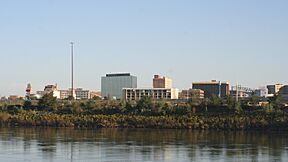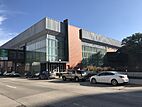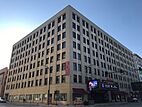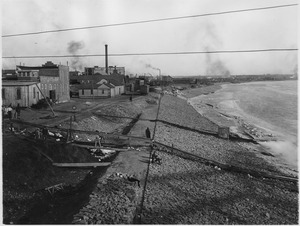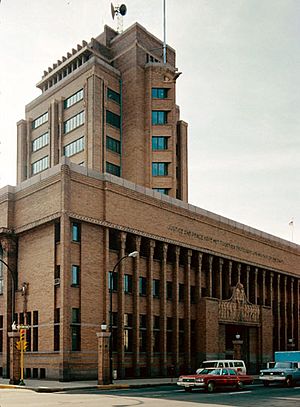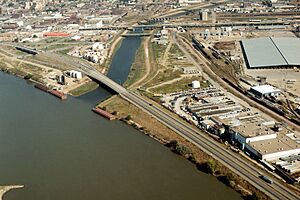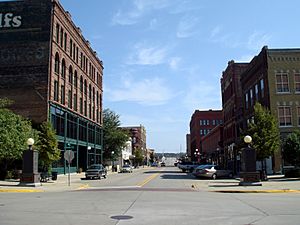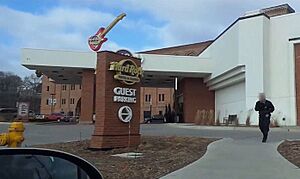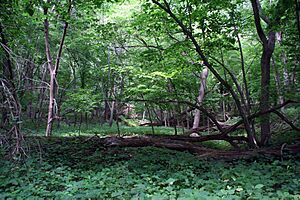Sioux City, Iowa facts for kids
Quick facts for kids
Sioux City
|
|
|---|---|
| Country | |
| State | |
| Counties | Woodbury, Plymouth |
| Founded | 1854 |
| Incorporated | 1857 |
| Area | |
| • City | 59.63 sq mi (154.4 km2) |
| • Land | 58.46 sq mi (151.4 km2) |
| • Water | 1.165 sq mi (3.02 km2) |
| Elevation | 1,201 ft (366 m) |
| Population
(2020)
|
|
| • City | 85,797 |
| • Rank |
|
| • Density | 1,467.6/sq mi (566.65/km2) |
| • Urban | 106,494 (US: 292nd) |
| • Metro | 149,940 (US: 284th) |
| • CSA | 175,638 |
| Time zone | UTC−6 (Central) |
| • Summer (DST) | UTC−5 (Central) |
| ZIP Codes |
51101–51104, 51106-51108, 51109-51111
|
| Area code(s) | 712 |
| FIPS code | 19-73335 |
| GNIS feature ID | 0461653 |
Sioux City is a city in Woodbury and Plymouth counties in the state of Iowa. In 2020, about 85,797 people lived here. This makes it the fourth-largest city in Iowa. Sioux City is the main city of a larger area called the Sioux City metropolitan area, which had 149,940 residents in 2020. Sometimes, Sioux City and nearby areas in Iowa, Nebraska, and South Dakota are called Siouxland.
Sioux City is located at the start of the Missouri River's navigable section. The city has many interesting places to visit. These include the Sioux City Public Museum, the Sioux City Art Center, and the Sergeant Floyd Monument. This monument is a National Historic Landmark. You can also visit Chris Larsen Park, known as "the Riverfront." It has the Anderson Dance Pavilion and the Sergeant Floyd River Museum & Welcome Center. There is also the Lewis and Clark Interpretive Center there.
Contents
- History of Sioux City
- Sioux City's Location and Climate
- People of Sioux City
- Sioux City's Economy
- Arts and Culture in Sioux City
- Sports in Sioux City
- Parks and Recreation in Sioux City
- Education in Sioux City
- Media in Sioux City
- Transportation in Sioux City
- Notable People from Sioux City
- Sister Cities
- See also
History of Sioux City
The area where Sioux City is now was once home to the Yankton Sioux. Spanish and French fur traders first visited in the 1700s. The first Americans to explore this area were Meriwether Lewis and William Clark. This happened in the summer of 1804.
Sergeant Charles Floyd was part of the Lewis and Clark Expedition. He died here on August 20, 1804. He was the only person to die during their two-and-a-half-year journey.
Sioux City was officially planned in the winter of 1854–1855. It quickly became an important travel center for people heading west. This included Mormons going to Salt Lake City and people looking for gold in Wyoming.
In 1891, the Sioux City Elevated Railway opened. It was one of the first elevated train systems in the world. It first used steam power, then switched to electricity in 1892. However, the railway closed within ten years.
On July 19, 1989, United Airlines Flight 232 crashed at Sioux Gateway Airport. Sadly, 112 people died, but 184 survived. This was thanks to the very fast help from local fire and emergency teams.
Sioux City's Location and Climate
Sioux City is located right next to two other states. To the west and northwest, it borders South Dakota. To the west, it also borders Nebraska.
The city covers about 59.63 square miles (154.44 square kilometers). Most of this area is land.
Sioux City's Weather
Sioux City has a humid continental climate. This means it has very warm and humid summers. The winters are cold and dry. Temperatures can change a lot throughout the year.
On average, the temperature is around 20°F (-6.7°C) in January. In July, it averages about 74.2°F (23.4°C). Each year, there are about 25 days that reach 90°F (32°C) or higher. There are also about 17 days when the temperature drops to 0°F (-18°C) or lower.
Most of the rain falls in May and June. The city gets about 29.27 inches (743 mm) of rain each year. Snowfall averages about 36.0 inches (91 cm) per winter season.
People of Sioux City
Sioux City has grown a lot over the years. Here's how the population has changed:
- 1870: 3,401 people
- 1890: 37,806 people
- 1920: 71,227 people
- 1950: 83,991 people
- 1980: 82,003 people
- 2020: 85,797 people
Sioux City's Diverse Community (2020)
In 2020, there were 85,797 people living in Sioux City. The city is home to many different groups of people.
- About 76.3% of the people were White.
- About 4.8% were African American.
- About 2.2% were Native American.
- About 2.9% were Asian.
- About 0.6% were Pacific Islander.
- About 10.1% were from other races or from two or more races.
- People of Hispanic or Latino background made up 20.9% of the population.
Sioux City has many people from different countries. These include people from West Africa, Somalia, Ethiopia, Vietnam, Mexico, and Guatemala. Many of these people have come for jobs in local factories.
Sioux City Metropolitan Area
The Sioux City Metropolitan Area includes four counties. In 2020, about 149,940 people lived in this larger area. The counties are:
Sioux City's Economy
Sioux City has many important businesses and employers. These companies provide many jobs for the people living in the city and surrounding areas.
Major Employers in Sioux City
Here are some of the biggest employers in Sioux City, based on 2020 information:
- Tyson Fresh Meats: This company is a large food producer. It employs about 4,500 people.
- Seaboard Triumph Foods: Another big food company, employing about 2,400 people.
- Sioux City Community School District: The local school system employs around 2,370 people.
- Bomgaars: A retail store chain with about 2,100 employees.
- Mercy Medical Center: A hospital that employs about 1,562 people.
- UnityPoint Health - St. Luke's: Another hospital, with about 1,500 employees.
- Hy-Vee: A popular grocery store chain, employing about 1,023 people.
- 185th Air Refueling Wing: A military unit that employs about 952 people.
- City of Sioux City: The city government itself employs about 878 people.
- Western Iowa Tech Community College: A college with about 700 employees.
These top employers show that Sioux City has a strong job market in food production, education, healthcare, and retail.
Arts and Culture in Sioux City
Sioux City offers many places to explore art, history, and music.
- The Sioux City Public Museum is now located downtown. It has exhibits about Native American history, pioneers, early Sioux City, and nature.
- The Sioux City Art Center started in 1938. It shows art from Iowa and the Midwest. It also has works by famous artists like Salvador Dalí and Grant Wood.
- The Sergeant Floyd Monument honors Sergeant Charles Floyd. He was the only person to die on the Lewis and Clark Expedition. The monument is a tall stone tower, about 100 feet (30 meters) high. It sits on a bluff with great views of the Missouri River.
- Chris Larsen Park, also called "The Riverfront," is a fun place to visit. It has the Anderson Dance Pavilion and the Sergeant Floyd Riverboat Museum. The Lewis and Clark Interpretive Center opened here in 2004.
- The Sioux City Symphony Orchestra (SCSO) began in 1915. They perform seven concerts each year at the Orpheum Theatre. They also teach music to thousands of young people.
- The Milwaukee Railroad Shop is a large area being restored by the Siouxland Historical Railroad Association. You can see a steam locomotive and a model railroad exhibit.
- Grandview Park is a large park north of downtown. It has a Municipal Bandshell where concerts are held. The Saturday in the Park music festival happens here every year. The park also has a beautiful rose garden.
- The historic Orpheum Theatre is downtown. When it was built in 1927, it was the largest theater in Iowa.
- Three main groups produce theater in Sioux City: the Sioux City Community Theatre (SCCT), LAMB Arts Regional Theatre, and Shot in the Dark Productions.
Sports in Sioux City
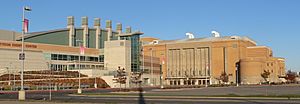
Sioux City is home to several sports teams that compete in different leagues.
- The Sioux City Bandits are an indoor football team. They play their games at the Tyson Events Center.
- The Sioux City Explorers are an independent baseball team. They play in the American Association. Their home games are at Lewis and Clark Park.
- The Sioux City Musketeers are a junior hockey team. They play in the United States Hockey League (USHL). They also play their home games at the Tyson Events Center. The Musketeers have won several championships, including the Clark Cup four times.
- In the late 1800s, the Sioux City Cornhuskers played baseball. This team later moved to Chicago and became the Chicago White Sox.
- The Sioux City Stampede plays amateur outdoor football.
- The Sioux City Swine is a rugby union team.
Parks and Recreation in Sioux City
Sioux City has many parks and outdoor areas for fun and relaxation.
- Stone State Park is in the northwest part of the city. It has beautiful views of the South Dakota/Iowa border. The park is great for picnics, hiking, and mountain biking.
- The Dorothy Pecaut Nature Center is inside Stone State Park. It has a special butterfly garden. You can often see wild turkeys and white-tail deer on the trails.
- Downtown entertainment includes the Hard Rock Hotel & Casino. There's also the 10,000-seat Tyson Events Center and the Sioux City Orpheum Theatre. The Anderson Dance Pavilion overlooks the Missouri River.
- Pulaski Park is named after Polish General Kazimierz Pułaski. He fought in the American Revolution. This park has baseball fields.
- Latham Park is in a neighborhood called Morningside. It was left as a park in 1937 by Clara Latham. The house and grounds are being restored.
- First Bride's Grave is in South Ravine Park. It's the grave of Rosalie Menard, the first non-Native American bride in Sioux City.
- War Eagle Park is named after Yankton Sioux chief Wambdi Okicize. A monument to him overlooks where the Big Sioux and Missouri Rivers meet.
- Riverside Park is along the Big Sioux River. It's one of the city's oldest recreation areas. It's home to the Sioux City Boat Club and Sioux City Community Theater. The first white settler's cabin, Théophile Bruguier, is preserved here.
- Bacon Creek Park is northeast of Morningside. It has a walking trail, a dog park, and picnic areas.
Sioux City also has several public golf courses. These include Floyd Park and Green Valley. There are also private golf clubs. The city has over 1,132 acres (4.58 square kilometers) of public parkland. There are also five public swimming pools in different neighborhoods.
Education in Sioux City
Sioux City offers many choices for learning, from elementary school to college.
Public Schools
The Sioux City Community School District serves many students. In the 2018-2019 school year, it had 14,569 students.
- There are three public high schools: West High School, North High School, and East High School (grades 9-12).
- There are three public middle schools: West Middle, North Middle, and East Middle (grades 6-8).
- The district also has 19 elementary schools (grades K-5).
Many nearby towns also have schools that serve students from the Sioux City area. These include South Sioux City, Hinton, and Sergeant Bluff.
Private Schools
Bishop Heelan Catholic Schools is a private school system. It includes six schools for students from preschool to twelfth grade.
Siouxland Christian School teaches students from pre-kindergarten through 12th grade. It started in 1959.
Colleges and Universities
Sioux City is home to several colleges and universities:
- Briar Cliff University
- Morningside University
- Western Iowa Tech Community College
- St. Luke's College of Nursing
- The Bellevue University outreach center
Media in Sioux City
Sioux City has many ways to get news and entertainment, including TV, radio, and newspapers.
Television Stations
- KTIV, Channel 4: This station is an NBC affiliate. It also has channels for CW, MeTV, Court TV, Ion Television, and Circle.
- KCAU-TV, Channel 9: This is an ABC affiliate. It also offers Ion Mystery, Laff, and Bounce TV.
- KMEG, Channel 14: This station is a Dabl affiliate. It also has channels for Charge! (TV network), Comet, and Stadium.
- KSIN, Channel 27: This is an Iowa PBS station. Its digital channels include PBS, PBS Kids, World Channel, and Create.
- KPTH, Channel 44: This station is a Fox affiliate. It also has channels for TBD, MyNetworkTV, and CBS.
Radio Stations (FM)
- KFHC-FM, 88.1: Catholic radio with EWTN programs.
- KWIT, 90.3: National Public Radio station.
- KMSC, 92.9: College radio station from Morningside University.
- KGLI, 95.5: "KG95," plays adult contemporary music.
- KSEZ, 97.9: "Z98," plays active rock music.
- KKMA, 99.5: "Classic Rock 99.5," plays classic rock.
- KKYY, 101.3: "Y101.3," plays country music.
- KQNU, 102.3: "Q 102.3," plays adult hits.
- KTFC, 103.3: Religious radio with the Bott Radio Network.
- KSUX, 105.7: "The SuperPig, K-Sioux 105.7," plays country music.
- KSFT-FM, 107.1: "107.1 KISS FM," plays top 40 music.
Radio Stations (AM)
- KMNS, 620: sports talk radio.
- KSCJ, 1360: talk radio.
- KWSL, 1470: Plays Spanish music.
Print Media
- Sioux City Journal: A daily newspaper for the Sioux City area.
- Dakota County Star: A weekly newspaper for northeast Nebraska.
- Sioux City Hispanos Unidos: A bi-weekly paper for Spanish readers.
- The Weekender: A weekly magazine about arts and entertainment.
- Siouxland Magazine: A quarterly magazine with community features.
Transportation in Sioux City
Sioux City has several ways to get around and connect to other places.
Highways
Major highways that pass through or near Sioux City include:
- Interstate 29
- Interstate 129
Public Transportation
Sioux City Transit runs several bus lines within the city. Buses meet downtown at the Martin Luther King Jr. Transportation Center. The Sioux City Paratransit offers door-to-door service for people who need extra help traveling.
Air Travel
The city is served by Sioux Gateway Airport (SUX). It is about 6 miles (9.7 km) south of the city.
Other Ways to Travel
- Jefferson Lines offers long-distance bus routes to Sioux City. You can travel to cities like Winnipeg, Kansas City, and Minneapolis.
- Several private taxi companies operate within the city.
- There are no passenger trains or water transportation services in the area.
- Big Soo Terminal offers barge transportation on the river.
Notable People from Sioux City
Many interesting and famous people have connections to Sioux City. Here are just a few:
- Oscar Micheaux: The first African American filmmaker in America.
- Art Babbitt: A famous animator who helped create the character Goofy for Disney.
- Dave Bancroft: A Baseball Hall of Fame shortstop and manager.
- Tommy Bolin: A musician who was a member of the bands Deep Purple and James Gang.
- Macdonald Carey: An actor best known for his role on Days of Our Lives.
- Ron Clements: A Disney animator and director for films like The Little Mermaid and Aladdin.
- Brigadier General George E. "Bud" Day: A highly decorated U.S. Air Force officer and Vietnam prisoner of war. Sioux City's airport is named in his honor.
- W. Edwards Deming: An expert in quality control who helped improve quality in Japan.
- Esther and Pauline Friedman: Better known as advice columnists Ann Landers and Abigail Van Buren.
- Fred Grandy: A television actor who played Gopher Smith on The Love Boat. He later became a U.S. congressman.
- Kirk Hinrich: A professional basketball player.
- Jerry Mathers: The actor who played Beaver Cleaver on TV's Leave It to Beaver.
- John Melcher: A U.S. Senator from Montana.
- Constance Moore: A singer and actress.
- John Osborn: A famous tenor singer.
- Paul Splittorff: A former Major League Baseball pitcher.
- Morgan Taylor: An athlete who won a gold medal in the 400-meter hurdles at the 1924 Olympics.
- Ted Waitt: Co-founder of Gateway, Inc., a computer company.
- Tony Watson: A former Major League Baseball all-star pitcher.
Sister Cities
Sioux City has special partnerships with other cities around the world. These are called sister cities.

 Lake Charles, Louisiana (since 1995)
Lake Charles, Louisiana (since 1995)
 Yamanashi, Yamanashi Prefecture, Japan (since 2003)
Yamanashi, Yamanashi Prefecture, Japan (since 2003) Template:Country data Gjilan Gjilan, Kosovo (since 2020)
Template:Country data Gjilan Gjilan, Kosovo (since 2020)
See also
 In Spanish: Sioux City para niños
In Spanish: Sioux City para niños


